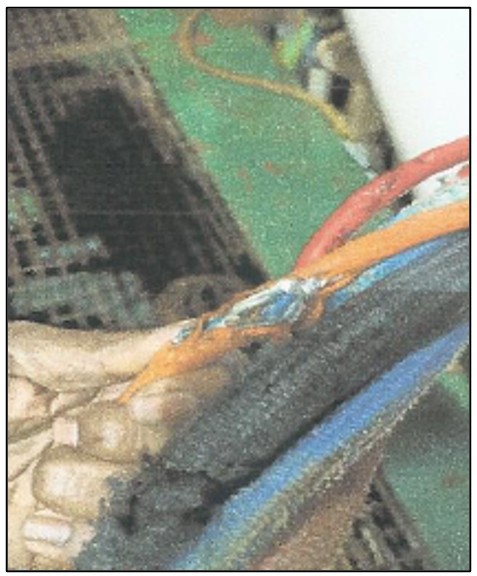Diver’s umbilical trapped during a pipeline flooding operation
What happened?
A saturation diver lost his breathing gas supply and had to go onto his emergency cylinder. The incident occurred on a moored 8-point construction barge during flooding operations near the pulling head of a newly laid pipeline. Water depth at the platform was 53 msw.
The pulling head of the newly laid line was in close proximity to another pipeline approximately 1.5m off seabed. Local arrangements consisted of a quarter turn valve and diffuser at the pulling head. Shortly after initiating the flooding, Diver 1 reported ”All Stop” as the pipeline shifted horizontally by approximately 1.5m. Diver 1 umbilical became trapped between two pipelines resulting in a lost video signal, a restriction of breathing gas and only 1 m of umbilical available for manoeuvring.
As Diver 2 approached to help, Diver 1 lost gas and went on his emergency gas cylinder. Diver 2 then provided pneumo gas to Diver 1 who turned off his “Bail-Out” to conserve emergency gas. Both divers worked in tandem to reconnect the pipe, lift it, and clear the umbilical. Once freed, breathing gas was restored to Diver 1 with 210 bar remaining in his “Bail Out Bottle”. Both divers were able to return to the bell.
Visibility was 1 to 2m with a significant but not excessive tidal current of 0.75 -1 kt.

What went right?
- Everyone in the team followed emergency procedures, communicated, and performed in an efficient and controlled manner;
- All evidence from the event was retained including the Black Box which was sent to shore for review;
- Witness statements received from the OCS, assistant dive supervisor, dive supervisor and the bell team were clear and well written.
What went wrong?
- It was not recognised that there was potential for movement of the pipeline during the flooding phase in combination with the relatively unstable configuration being used;
- Despite numerous / continued reminders and confirmations that the umbilicals were clear, the trapping still occurred.
What was the cause
- The “as left” condition of the pipeline off the seabed and resting on top of other pipelines.
- The tidal current was pushing umbilicals against an elevated pipeline.
- Movement of the pipeline was due to a shift in weight as a consequence of flooding. When flooding started, the centre of gravity changed causing the pipeline to shift towards the diver;
- The divers’ umbilicals were routed over and parallel to the pipes allowing portions to dip into a pinch point area.
Lessons
- Flooding a pipeline is a dynamic undertaking which may have unexpected consequences;
- “As found” or “as left” conditions should be inspected and assessed for potential hazards before starting work;
- Umbilical management should take into consideration numerous changing variables.
Members may wish to refer to:
Safety Event
Published: 3 June 2024
Download: IMCA SF 11/24
IMCA Safety Flashes
Submit a Report
IMCA Safety Flashes summarise key safety matters and incidents, allowing lessons to be more easily learnt for the benefit of all. The effectiveness of the IMCA Safety Flash system depends on Members sharing information and so avoiding repeat incidents. Please consider adding [email protected] to your internal distribution list for safety alerts or manually submitting information on incidents you consider may be relevant. All information is anonymised or sanitised, as appropriate.
IMCA’s store terms and conditions (https://www.imca-int.com/legal-notices/terms/) apply to all downloads from IMCA’s website, including this document.
IMCA makes every effort to ensure the accuracy and reliability of the data contained in the documents it publishes, but IMCA shall not be liable for any guidance and/or recommendation and/or statement herein contained. The information contained in this document does not fulfil or replace any individual’s or Member's legal, regulatory or other duties or obligations in respect of their operations. Individuals and Members remain solely responsible for the safe, lawful and proper conduct of their operations.
